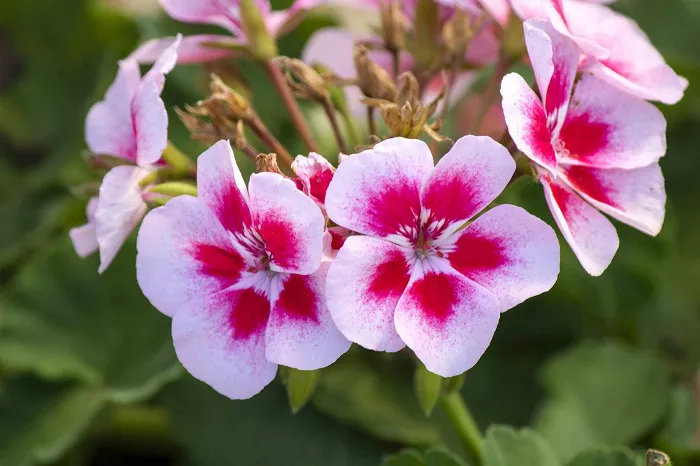Geraniums are beloved for their vibrant blooms and easy-care nature. Yet, many gardeners find themselves puzzled when these plants fail to flower as expected. Whether you’re a seasoned gardener or a novice, understanding the key factors that influence geranium flowering can transform your garden into a sea of color. This guide will delve into the secrets of encouraging your geraniums to produce those stunning flowers.
Optimal Growing Conditions for Geraniums
Light Requirements
Geraniums thrive in full sun, requiring at least six to eight hours of direct sunlight daily. Insufficient light can lead to sparse foliage and few, if any, flowers. Place your geraniums in a sunny spot, such as a south-facing window or a garden bed that receives ample sunlight. If natural light is limited, consider supplementing with grow lights to ensure they receive the necessary light spectrum for robust growth and flowering.
Temperature and Climate
These plants prefer moderate temperatures, ideally between 60 and 70 degrees Fahrenheit during the day, and slightly cooler at night. Extreme heat or cold can stress the plant and inhibit flowering. In hot climates, provide some afternoon shade to prevent wilting, while in cooler regions, protect them from frost by bringing them indoors or covering them during cold snaps.
Soil and Watering
Soil Quality
Geraniums need well-draining soil to prevent waterlogging, which can lead to root rot and poor flowering. A mix of equal parts potting soil, perlite, and peat moss works well. Ensure the soil is rich in organic matter to provide essential nutrients. Adding compost or aged manure can enhance soil fertility and promote healthy root development.
Watering Practices
Consistent watering is crucial, but overwatering can be detrimental. Allow the top inch of soil to dry out between waterings. When watering, thoroughly soak the soil until water drains from the bottom of the pot. This ensures the roots receive adequate moisture without becoming waterlogged. During hot, dry spells, increase watering frequency, but always check the soil moisture level first.
Nutrient Management
Fertilization
Regular feeding is essential for abundant blooms. Use a balanced, water-soluble fertilizer with an N-P-K ratio of 10-10-10 or 20-20-20 every two weeks during the growing season. Alternatively, apply a slow-release fertilizer at the beginning of the season to provide a steady supply of nutrients. Avoid over-fertilizing, as this can lead to excessive foliage growth at the expense of flowers.
Micronutrients
In addition to macronutrients, geraniums benefit from micronutrients such as iron, magnesium, and calcium. These can be added through foliar sprays or soil amendments. A deficiency in these nutrients can result in yellowing leaves and poor flowering, so monitor your plants closely for any signs of nutrient stress.
Pruning and Maintenance
Pinching and Deadheading
Regular pinching and deadheading are vital for promoting continuous flowering. Pinch back the tips of young plants to encourage bushier growth and more flowering stems. Remove spent blooms promptly to prevent the plant from setting seed, which can divert energy away from producing new flowers. Use sharp, clean scissors to avoid damaging the plant.
Pest and Disease Control
Keep an eye out for common pests such as aphids, whiteflies, and spider mites, which can weaken the plant and reduce flowering. Treat infestations promptly with insecticidal soap or neem oil. Ensure good air circulation around the plants to prevent fungal diseases like powdery mildew, which can also inhibit flowering.
Seasonal Care
Spring and Summer
Spring is the prime time for geraniums to start flowering. Ensure they receive plenty of sunlight, water, and nutrients during this period. Monitor for any signs of pests or diseases and address them immediately. In summer, protect the plants from extreme heat and drought by providing shade and consistent watering.
Fall and Winter
As temperatures cool, reduce watering and fertilization. In regions with frost, bring potted geraniums indoors or cover outdoor plants with frost blankets. Prune back any dead or damaged growth to prepare the plant for dormancy. With proper care, your geraniums can survive the winter and bloom again in spring.
Special Tips for Indoor Geraniums
Light and Temperature
Indoor geraniums require bright, indirect light. Place them near a south-facing window or use grow lights if natural light is insufficient. Maintain a consistent temperature between 65 and 70 degrees Fahrenheit during the day and slightly cooler at night to mimic their natural growing conditions.
Humidity and Airflow
Indoor environments can be dry, especially during winter heating. Increase humidity around your geraniums by placing a tray of water with pebbles beneath the pot or using a humidifier. Ensure good air circulation to prevent fungal diseases, but avoid placing the plant in drafty areas.
Common Mistakes to Avoid
Overwatering and Poor Drainage
One of the most common mistakes is overwatering. Ensure your pots have drainage holes and use well-draining soil to prevent waterlogging. Always check the soil moisture level before watering.
Insufficient Light
Geraniums need plenty of sunlight to flower. If your plants are not receiving enough light, they may produce sparse blooms or none at all. Move them to a sunnier location or supplement with grow lights.
Over-Fertilization
While nutrients are essential, over-fertilization can lead to excessive foliage growth and fewer flowers. Follow the recommended dosage on your fertilizer and avoid frequent, heavy applications.
Conclusion
Encouraging your geraniums to flower is a rewarding process that requires attention to their specific needs. By providing optimal light, temperature, soil, and water conditions, along with regular pruning and pest control, you can enjoy a vibrant display of blooms. Whether grown indoors or outdoors, these versatile plants can brighten any garden or home with their colorful flowers.


